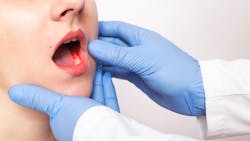But I brush my teeth: 10 causes of periodontitis that go beyond oral hygiene
As a dental professional, I sometimes have to tell patients unpleasant facts about their teeth and gums. When patients swear they practice good oral hygiene, it’s difficult to advise them that they have gum disease, an infection of the gums that hold our teeth in place. But there are many reasons for these types of gum infections since periodontal disease is caused by much more than poor oral hygiene. Here’s a look at some of the other factors that can contribute, as well as at gum disease treatment.
Genetics
Gum disease can run in families. A family history could make you more susceptible to this oral bacterial infection. If you think you could be genetically predisposed, diligent oral hygiene, again, becomes more crucial.
Aggressive bacteria
Some patients acquire virulent bacteria that are more destructive to gums and bone support for teeth. This can cause bleeding and bone loss with tooth mobility, without the patient experiencing telltale pain. Patients with this type of gum disease need treatment since oral hygiene alone is ineffective.
Medications
A multitude of medications can lead to bleeding issues or enlarged gum tissue. Some medications can result in “dry mouth,” which lets bacteria spread faster. Long-term use of many liquid medications, antacids, and cough drops that have been sweetened with sugar can make oral hygiene even more important.
Smoking
It’s not just cigarettes that are a problem when it comes to oral health. Tobacco use in any form—including cigars, pipes, chewing tobacco, e-cigarettes, and vaping—put people at two to three times greater risk of getting gum disease. Smoking slows the natural tissue healing process in the mouth and makes it more prone to infection. The more and longer someone smokes are both factors that increase the risk of gum disease. The Centers for Disease Control and Prevention (CDC) reports that periodontal disease (severe gum disease) is more prevalent in men (56.4%) than women (38.4%) and even more so in smokers (64.2%).
Pregnancy and hormonal shifts
Patients may need to practice greater oral hygiene if they’re expecting or even during menstrual cycles. Hormonal fluctuations can make gums more prone to gum disease. Active periodontal disease in pregnant women has been linked to complications such as low birth weight and premature birth.
Nutritional deficiencies
Bleeding gums can point to gingivitis, which is the early stage of gum disease. But bleeding can also indicate a deficiency in nutrients like Vitamin C. Adding healthy foods like carrots, sweet potatoes, and oranges may help. Poor nutrition in general can negatively affect the body’s immune system.
Age
According to the CDC, more than 64 million adults over age 30 in the U.S. have some form of periodontal disease. And the risk increases with age, much like our risk for other medical disorders. Statistics from the American Academy of Periodontology show that the risk for periodontal disease, the most serious form of gum disease, increases to over 70% in adults over age 65.
Poor brushing techniques
Some patients brush only once a day, and those people tend to do so in the mornings. Once a day brushing simply isn’t enough. Skipping nighttime brushing allows plaque to grow and multiply, undisturbed. Reduced saliva flow at night means teeth are even more susceptible to bacteria from the tiny food particles stuck in the teeth during the day. Bad “morning” breath is only one consequence.
Brushing too hard is also an issue. It can lead to gum recession, which causes “pockets” where bacteria can more easily build up. And many patients simply aren’t spending enough time brushing—two minutes seems to be a good norm—or they’re not brushing correctly.
A lack of flossing
A few years back, flossing made the news when a sensational Harris Poll survey conducted online on behalf of the American Academy of Periodontology showed that more than a quarter of Americans lie to their dentists about flossing. Daily flossing is important—it reaches pockets that brushing or even mouthwash can’t tackle. Even if you see blood when you floss, you should continue the daily practice. And we recommend you use dental floss, not picks, if possible, to reach down into the cracks between your teeth.
Overall health issues
Heart disease, diabetes, and rheumatoid arthritis are three examples of systemic diseases that cause inflammation that can worsen gums’ condition. And numerous studies in the last few decades concurrently link gum disease to an increase in those same diseases. Harmful bacteria in the mouth are thought to travel from the mouth into the bloodstream and lungs.
Gum disease treatment
Today’s periodontal offices offer many nonsurgical treatment options including two-part deep cleaning known as scaling and root planing. LANAP® laser therapy is minimally invasive and safely “vaporizes” diseased gum tissue while leaving behind healthy tissue. It’s especially recommended for patients on blood thinners, or those with diabetes and other long-term conditions.
Talk to your dentist or periodontist to obtain a diagnosis and discuss gum disease treatment options. Most offices will educate patients about proper brushing and flossing techniques. Regardless of why you have gum disease, now’s the time to treat it.
About the Author
Frederic J. Norkin, DDM
Dr. Frederic J. Norkin is a founding partner at Boca Raton’s South Florida Center For Periodontics & Implant Dentistry. He is a Diplomate of the American Board of Periodontology and a Fellow of the International Team for Implantology.
